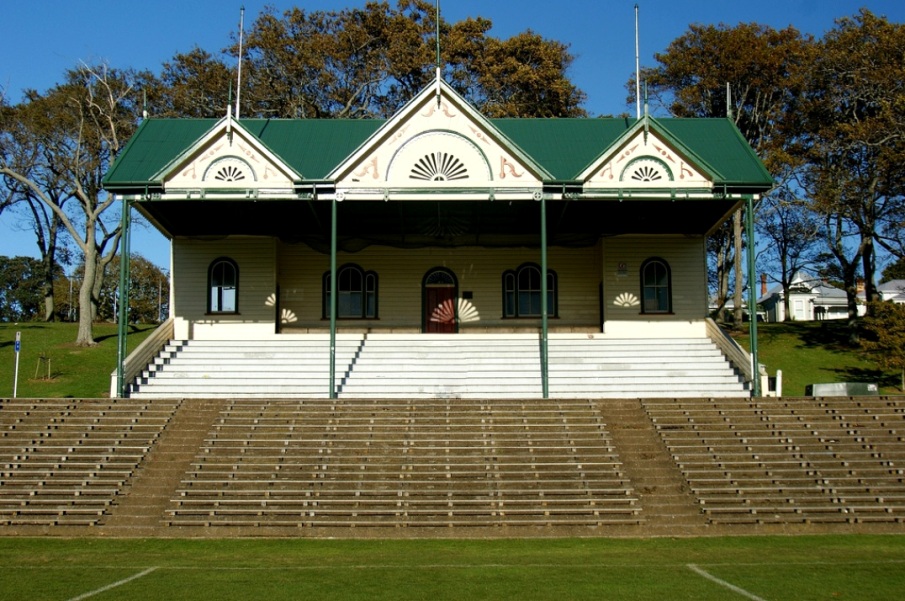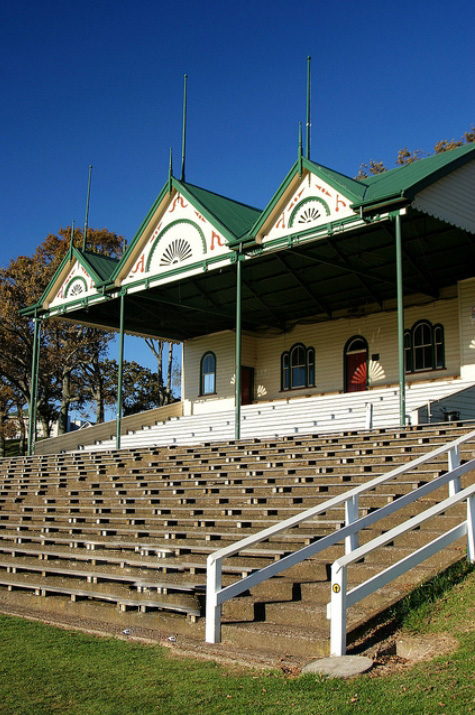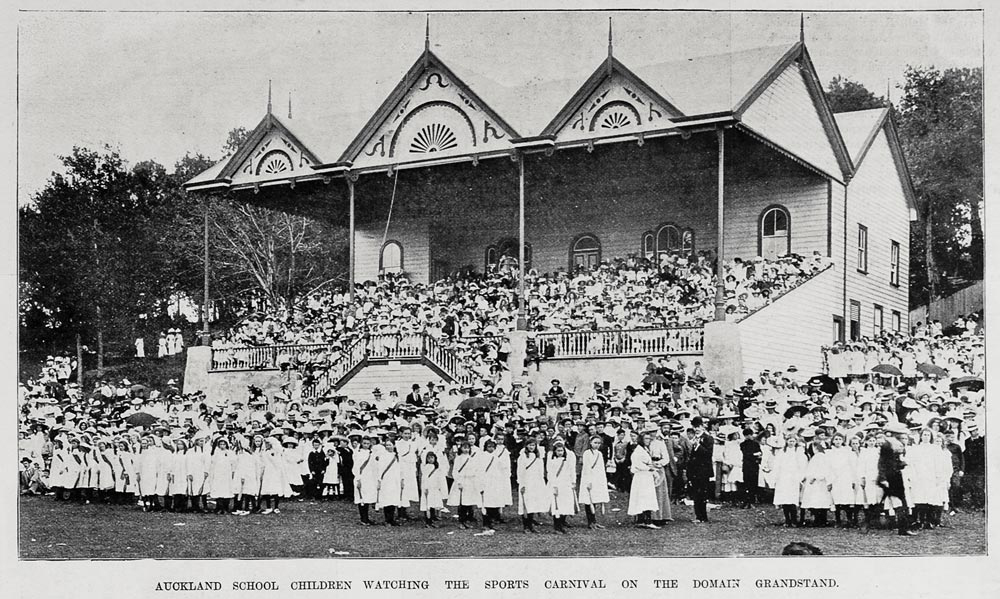Cricket in the Auckland Domain Constructed in 1898, the Pavilion is closely linked with the development of recreation in the Auckland Domain, and particularly the game of cricket. Cricket was introduced into New Zealand by the first colonial settlers, with the first recorded game being played in December 1832 in the vicinity of Paihia, in the Bay of Islands. Cricket clubs were formed in Auckland soon after the foundation of the town in 1840-1841, and development of the game was further stimulated by the arrival of British troops, who formed a cricket pitch at the Albert Barracks. By 1853, cricket was considered to be one of the chief outdoor amusements of the settlement. With the rapid growth of Auckland in the 1860s, there were calls for the development of recreation areas, including cricket grounds. The largest of the city parks developed for this purpose was the Auckland Domain, an 80 hectare (200 acre) block of land which was Auckland's oldest park. Sporting facilities were introduced to the Domain in the early 1860s, when the Auckland Bowling Club formed greens close to Stanley Street and a public cricket ground was established. The latter occupied swampy ground 'within the enclosure at the rear of the Government Botanical garden at present covered by Manuka scrub', which had previously been used for eeling by local Maori and duck shooting by European settlers. Work on the cricket ground started in 1864 but was not completed until ten years later. In November 1874 the ground was opened with a match of 'England v. World'. The Daily Southern Cross reported of its associated facilities: 'Mr Brighton has erected a comfortable and commodious arbour for the use of the cricketers and public, where refreshments, including strawberries and cream, can be obtained. In 1879 the cricket ground was extended by a further three acres and plans were made for the erection of a pavilion. This was erected by 1883 after a public appeal for funds raised £200 towards the project. Inter-provincial and international cricket matches were played at the Domain ground, including a match between England and Auckland in early 1882. In 1890 the pavilion was extended by the Auckland City Council, who had taken over control of the park in 1884. Use of the ground was not solely restricted to cricket, and in the 1890s the sport of cycling developed locally. The Domain ground and pavilion was also utilised by the Auckland Amateur Athletics Club for their two carnivals each year. While sports events in the Domain were popular with spectators it appears that other entertainment was often provided. Local bands offered musical entertainment while ladies promenaded. Construction of the current Cricket Ground Pavilion By the mid 1890s the first pavilion had become dilapidated and in late 1897 it was burnt down. In January a meeting was held with representatives of the Auckland City Council, Domain Ground Committee, Auckland Cricket Association, Auckland Cycle Club and the Auckland Amateur Athletic and Cycle Club to discuss the erection of a new building. A plan for a new pavilion with an estimated cost of £800 was presented to the meeting by 'an old cricketer' but it appears that this plan was abandoned while the issue of funding the building was resolved. It appears that a Domain Pavilion Sports Committee was formed to raise funds for the new structure. They sought additional funding from the council to pay for the new pavilion which they intended to erect. The council initially requested that the Domain Cricket Ground Committee submit a plan and estimate of the new pavilion for council approval. However, the Council soon elected to build the pavilion themselves and take over its management. In September 1898 the Domain Pavilion Sports Committee forwarded £200, raised for the new building through sports events held in the Domain. In September 1898 plans prepared by the Auckland City Council Engineer, William Anderson, were presented to the Council for a 'Cricket Ground Pavilion'. Anderson was the first appointee to the post of Director of Works and Engineer at Auckland City Council, a position he held from 1871 until 1899. Tenders were called, and the lowest of the eleven received -that of James Lye & Sons at £896 -was accepted. The Council had elected to raise the remaining funds needed by loan, with the rents from the pavilion repaying the borrowed funds. By mid December the pavilion was completed and was described in the local press as 'handsome and commodious, and . . . an ornament to grounds in which it stands.' The pavilion was a facility used by a wide range of sporting groups who made use of the cricket ground. Lacrosse, cycling, athletics, football and cricket were all played on the cricket field, while schools, churches and cultural groups all made use of the cricket ground and pavilion for sporting and social events. Major cricket games continued to be played at the Domain ground until 1913 when Eden Park became the preferred venue for representative cricket. However, local teams continued to play at the Domain. The pavilion and grandstand has been part of a number of important events in the city of Auckland. In 1920 it was specially decorated and thronged with crowds during the visit of the Prince of Wales. In January 1940 a crowd of 10,000 watched from the grandstand and surrounding grassy slopes as a thanksgiving service was held at the cricket ground to mark the beginning of the centennial celebrations. The open-air service was included a reading by the Governor-General, Viscount Galway, and a choir of 500 led by the Newton Salvation Army Band. It formed the main event of the celebrations in Auckland. Just days earlier the pavilion had overflowed with spectators watching the troops of the first echelon of the second New Zealand division parade in the cricket ground. In 1953, additional open terracing was built on the slope below the grandstand for the visit of Queen Elizabeth II. The pavilion has continued to serve the people of Auckland, and the cricket ground remains a well-used sports facility, being the oldest cricket pitch in the city still in use. The 'Auckland Domain Plan' produced for the Auckland City Council in 1993 noted that the nineteen cricket pitches in the Domain 'form the most concentrated area in the Southern Hemisphere for this purpose'. The pavilion recently underwent a $650,000 upgrade, which involved redevelopment of the basement area so that the sports teams' changing rooms could be moved downstairs. This allowed the upstairs facilities to be improved, particularly for the performers that use this area during the annual concerts in the park. The restored cricket pavilion is dedicated to the memory of Auckland cricketer Charles Kerr (1906-1985), who played cricket on the Auckland Domain Grounds for 61 summers. Kerr's ashes were spread over the number one field, which the pavilion overlooks.



Location
List Entry Information
Overview
Detailed List Entry
Status
Listed
List Entry Status
Historic Place Category 2
Access
Able to Visit
List Number
569
Date Entered
6th June 2005
Date of Effect
6th June 2005
City/District Council
Auckland Council
Region
Auckland Council
Extent of List Entry
The registration includes part of the land in RT NA75C/138 (as shown on Map C in Appendix 4) and the building, its fixtures and fittings, thereon. It includes the open terraced seating to the north of the pavilion building.
Legal description
Part of Pt Auckland Domain (RT NA75C/138)
Related listings
Stay up to date with Heritage this month
